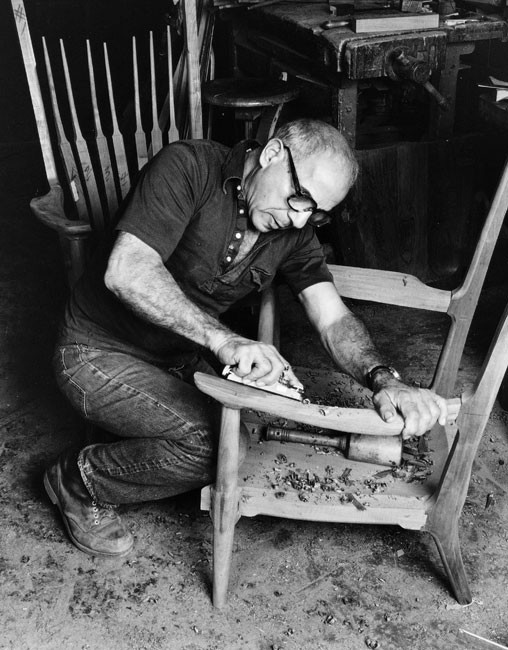
Sam Maloof working in his shop, 1978. (Photo, Jonathan Pollock.)

F. Hollyer, Portrait of William Morris, 1887. Photograph. (Courtesy, Huntington Library, Art Collections, and Botanical Gardens.)

Exterior view of the Sam Maloof home and studio, Alta Loma, California. (Photo, Jonathan Pollock.)

Exterior view of the Wharton Esherick home and studio, Paoli, Pennsylvania. (Courtesy, Wharton Esherick Museum.)
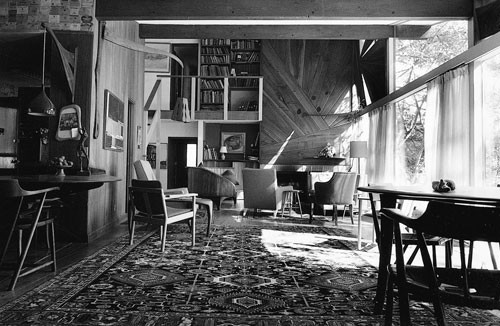
Living room interior of the home owned by Lawrence and Alice Seiver, Villanova, Pennsylvania. (Courtesy, Wharton Esherick Museum.) Esherick provided much of the paneling, built-in furniture, lighting, and movable furniture in the 1950s and 1960s.
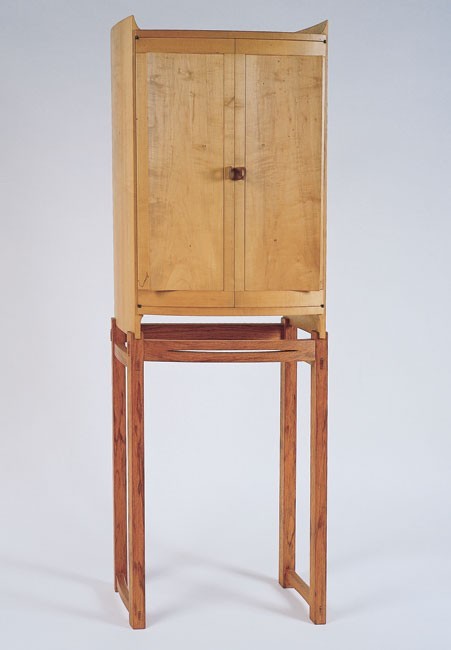
James Krenov, cabinet. Fort Bragg, California, 1982. Maple, red oak, and partridge. H. 67", W. 27", D. 11". (Courtesy, Pritam & Eames.)
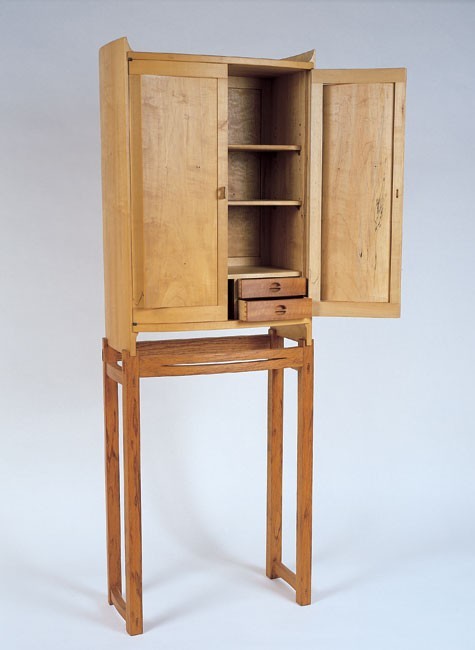
View of the cabinet illustrated in fig. 6 with the door open.
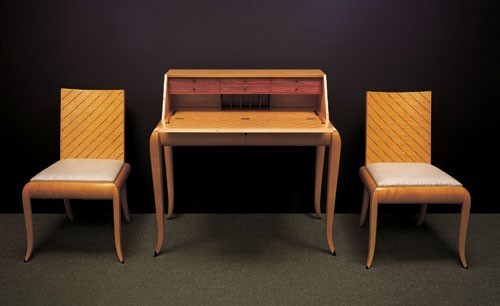
Wendell Castle, lady’s desk with two chairs, Scottsville, New York, 1981. Curly English sycamore, purpleheart, ebony, delrin, and Baltic birch plywood. Desk: H. 40 3/4", W. 41 1/2", D. 22 1/4"; chair: H. 34 3/4", W. 21", D. 26". (Courtesy, Wendell Castle.)
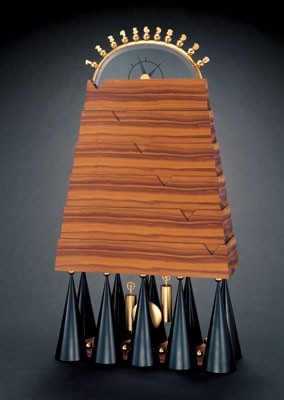
Wendell Castle, Ziggeraut, Scottsville, New York, 1985. Gabbon ebony, curly koa veneer, leather, and gold-plated brass; weightdriven movement. H. 71", W. 39", D. 15". (Courtesy, Wendell Castle.)
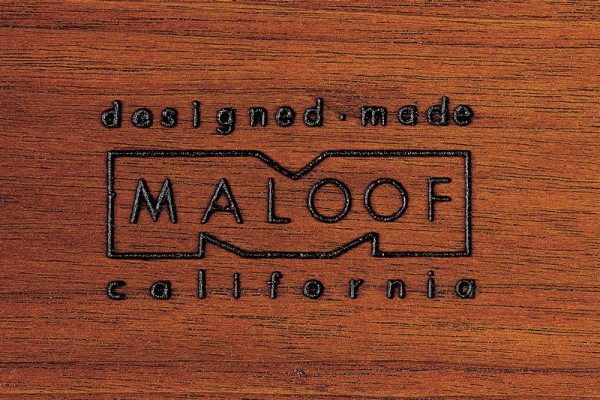
Brand used by Sam Maloof from the late 1950s to 1971. (© Smithsonian Institution; photo, Jonathan Pollock, 2001.)
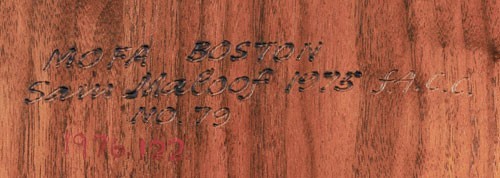
Burned signature used by Sam Maloof from 1975 to 1992. (Courtesy, Museum of Fine Arts, Boston.)
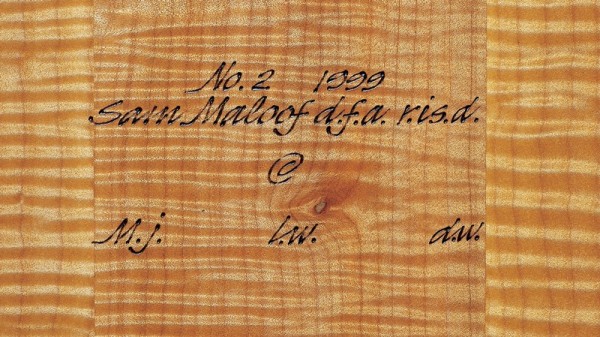
Burned signature used by Sam Maloof after 1992. (© Smithsonian Institution; photo, Jonathan Pollock, 2001.)

Carved inscription used by Wendell Castle before 1978. (Courtesy, Museum of Fine Arts, Boston.)

Carved inscription used by Wendell Castle from 1978 to 1984. (Courtesy, Museum of Fine Arts, Boston.)
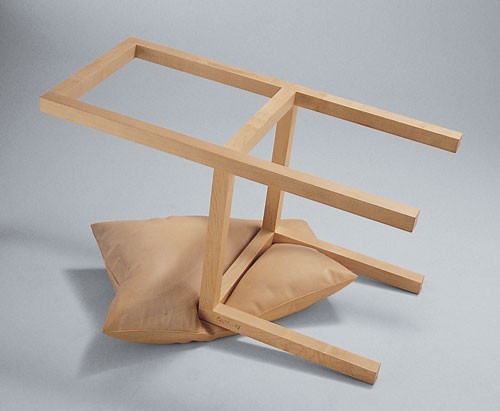
Signature used by Wendell Castle from 1984 on. (Courtesy, Pritam & Eames.) The signature is visible on the right front leg.
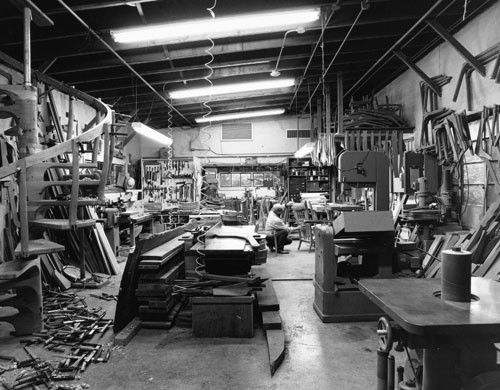
Sam Maloof workshop, 1981. (Photo, Jonathan Pollock.)
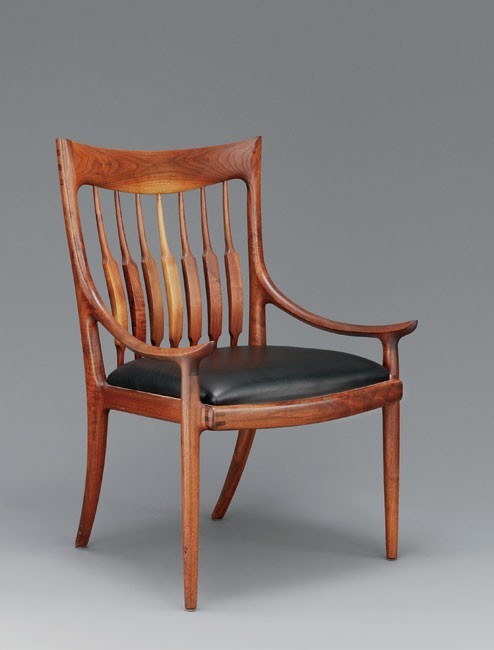
Sam Maloof, armchair, Alta Loma, California, 1975. Walnut and black vinyl. H. 38", W. 30", D. 22 1/2". (Courtesy, Museum of Fine Arts, Boston; purchased through funds provided by the National Endowment for the Arts and the Gillette Corporation.)
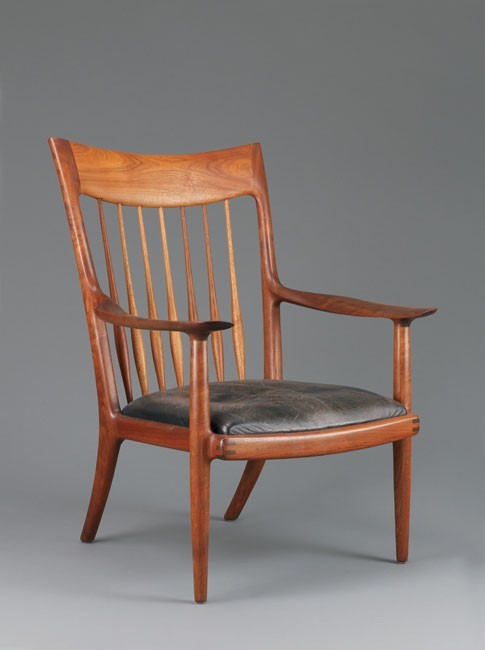
Sam Maloof, armchair, Alta Loma, California, 1975. Walnut and black vinyl. H. 38 1/2", W. 30", D. 25 3/4". (Courtesy, Museum of Fine Arts, Boston; purchased through funds provided by the National Endowment for the Arts and the Gillette Corporation.)
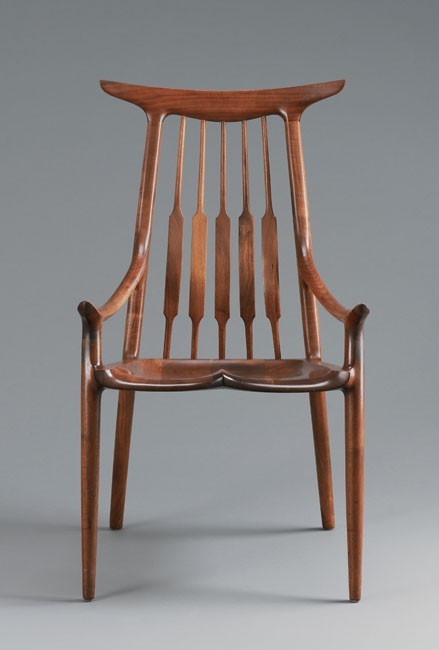
Sam Maloof, armchair, Alta Loma, California, 1975. Walnut. H. 39 3/4", W. 22", D. 23". Courtesy, Museum of Fine Arts, Boston; purchased through funds provided by the National Endowment for the Arts and the Gillette Corporation.)

Wendell Castle, Molar chair, manufactured by Northern Plastics Corporation for Beylerian Limited, 1969–1970. Glass-reinforced polyester. H. 26", W. 36", D. 30". (Courtesy, Detroit Institute of Arts.)
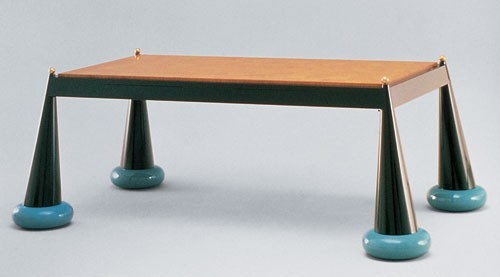
Wendell Castle, protoype for the Atlantis desk, designed for the Gunlocke Company, 1982. Ebonized and lacquered cherry, flakeboard, beeswing narra veneer, plastic inlay, and gold-plated brass. H. 29", W. 72", D. 36". (Courtesy, Wendell Castle.)
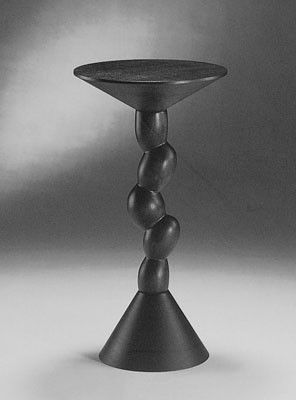
Wendell Castle, Huevos table, 1999. Mahogany. Dimensions not recorded. (Courtesy, Wendell Castle.)

Stamp used by Wendell Castle on his designs for Icon Furniture. (Courtesy, Wendell Castle.)

Sam Maloof, settee, Alta Loma, California, 1987. Curly maple. H. 30", W. 42", D. 25". (Photograph 2003 © Metropolitan Museum of Art; gift of the artist and purchase, anonymous gift.)
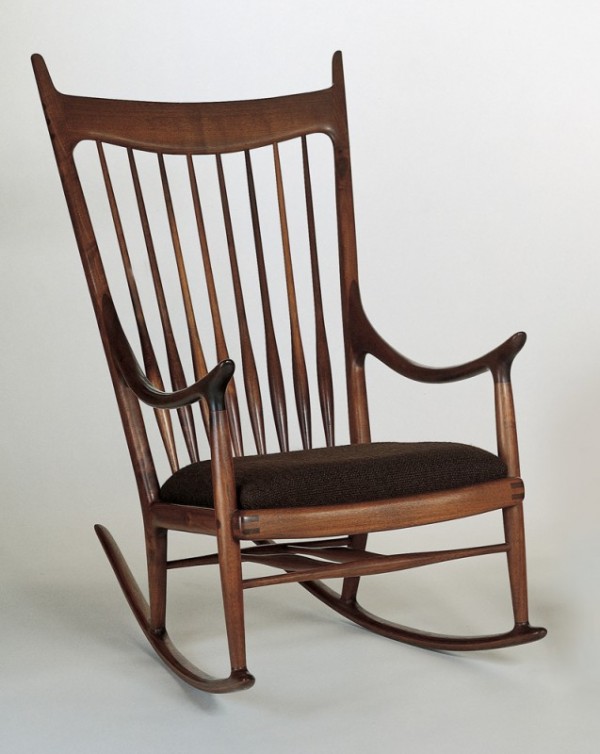
Sam Maloof, spindle-back rocking chair, Alta Loma, California, 1968. Walnut and leather. H. 44 7/8", W. 26", D. 42 1/8". (© Smithsonian Institution; photo, Jonathan Pollack, 2001.)

Sam Maloof, rocking chair, Alta Loma, California, 1975. Walnut. H. 44 1/2", W. 27 3/4", D. 46". (Courtesy, Museum of Fine Arts, Boston; purchased through funds provided by the National Endowment for the Arts and the Gillette Corporation.)
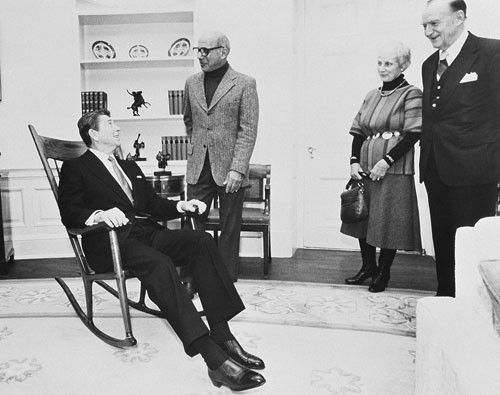
President Ronald Reagan accepting the gift of a Maloof rocking chair, November 11, 1981. (Courtesy, Sam Maloof.) Sam and Freda Maloof and Clement Conger look on.
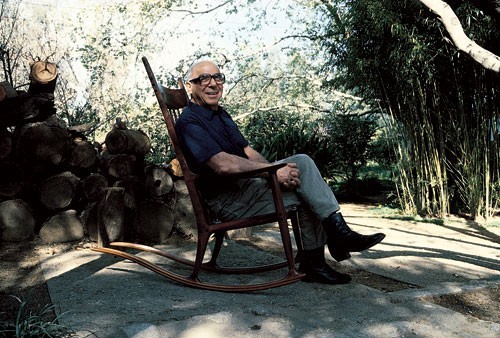
Sam Maloof sitting in one of his rocking chairs. (Photo, Rick Mastelli.)
The study of American furniture from the last half of the twentieth century has been hindered by a pervasive scholarly balkanization. The terms decorative arts, design, art, and material culture have come to be distinct in terms of subject matter, approach, scholarship, and representation. For example, the works of Wendell Castle, Charles Eames, Robert Venturi, and Donald Judd tend to appear in different exhibition and publication venues, elicit different interpretive questions, and figure in different histories of American domestic goods. Such a state contrasts noticeably with British design history, which has taken a more ecumenical and theoretically-based view of material culture, one that looks at material expression whether a craftsperson, designer, architect, or artist has had a hand in its production, while American scholars of twentieth-century material culture remain mired in the celebration of either individual craftspeople or designers and emphasize historical narrative at the expense of critical analysis or interpretation. This essay focuses specifically on the decorative arts ideology deployed in the study of studio furniture, exploring its beginnings and demonstrating how this fissure might be repaired.[1]
In its most public guises—museums and journals—the past century’s material culture rarely exists as a coherent package. Many museums have departments of American decorative arts that focus on work made before 1920 (up through the arts and crafts movement, celebrated as the last gasp of the individual craftsman) and assign responsibility for the twentieth century to different departments of design or contemporary art. In some other museums, departments of American decorative arts focus on one-off craft objects and luxury goods of the twentieth century, identifying them as the logical extensions of the historical collections, and thereby include only a small part of the period’s material culture. Such institutions reject the industrial or commercial products of the past century, seeing them as commonplace kitsch. Few institutions collect and display a wide variety of objects from the twentieth century. The split is also seen in the mutually exclusive contents of design magazines such as Metropolis and Design Issues, on the one hand, and decorative arts periodicals such as Antiques and American Craft, on the other. The origin of manufacture, the role of machinery, the numbers produced, and the market all play an important role in distinguishing an object’s taxonomical category, exhibition relations, publication venue, and scholarly attention. Separate, distinct discourses characterize the American field.[2]
Compartmentalization can also be seen in much of the scholarship on American studio furniture produced in the past quarter of a century. A recent example, The Furniture of Sam Maloof, is the latest and largest consideration of that individual furniture maker (fig. 1). Much of the work on Maloof celebrates his singular genius, draws on a general context to provide background for hagiography, makes uncritical use of the maker’s own words and philosophy to bestow meaning on the work, and relies on a descriptive consideration of the objects that focuses upon technique. Such an approach links current work on studio craft to the conservative decorative arts canon, discussed by Jonathan and Katherine Prown in the 2002 volume of American Furniture, rather than examining this work within the context of various modes of furniture production or under the lens of material and visual culture theory. Why has this canon colored the focus of twentieth-century decorative arts, favoring the studio crafts and precluding design and theory? The investigation of this question leads back to William Morris (1834–1896), the English designer-craftsman, social critic, writer, and socialist (fig. 2).[3]
Morris was one of the first writers, and certainly the most prolific and influential, to use the term “decorative arts” in the manner in which we commonly understand it today, as “that great body of art, by means of which men have at all times more or less striven to beautify the familiar matters of everyday life.” By focusing on “ornamental workmanship,” Morris sought to elevate quotidian objects so that society ascribed value to them even though they might not equal the “higher” “arts of the intellect” (architecture, painting, and sculpture). In his call for serious consideration of this class of artistic production, Morris popularized the term decorative art, rejecting the other period terms such as “industrial arts” and “applied arts” because of their manufacturing and commercial connotations. Morris’ extensive writings inspired many American cultural capitalists and early museum professionals, who then began to collect and institutionalize decorative arts at the turn of the century, thereby ensuring that Morris’ terms and criteria became the foundation for the field. Therefore it is important to recognize Morris’ particular construction of the decorative arts. Two themes stand out in his writings on the subject—his sense of history and his great esteem for the maker.[4]
Responding against the misery, alienation, and inequities of the contemporary British economy, Morris looked back to the fourteenth and fifteenth centuries as an idealized organic past. He wrote how craftsmen at that time had their own fields or lived adjacent to sites of agricultural production, were complete masters of their tools, enjoyed a rhythm of work that combined artisanal freedom and harmonious cooperation, and produced worthy objects. A certain communalism, born of the agrarian life and fostered by church fellowship, circumscribed the craftsman:
The theory of industry among these communes was something like this. There is a certain demand for the goods which we can make, and a certain population to make them: if the goods are not thoroughly satisfactory we shall lose our market for them and be ruined: we must therefore keep up their quality to the utmost. Furthermore the work to be done must be shared amongst the whole of those who can do it, who must be sure of work always as long as they are well behaved and industrious.
For Morris, we should learn from history and use it as a template for reform and restructuring. History was the supreme teacher that would guide and inspire those living in the present. Morris also believed that object making was ultimately a local activity, rooted in a specific context for an immediate audience.[5]
The other tenet central to Morris’ writings was his supreme regard for the individual craftsman as the heart of a successful society. Morris celebrated the craftsman for his ability to create a “new art of conscious intelligence” that was distinct from “mechanical toil,” the useless work that provided the baubles of contemporary fashion. Deriving great pleasure in his activity, the true craftsman used dexterity and thoughtfulness within the comforts of the guild and the local community to improve the built environment. To Morris, there was direct linear linkage from harmonious thoughts and processes to beautiful built environments and harmonious societies. In celebrating the medieval craftsman who designed his own products, Morris wrote:
The medieval man sets to work at his own time, in his own house; probably makes his own tool, instrument, or simple machine himself, even before he gets on to his web, or his lump of clay, or what not. What ornament there shall be on his finished work he himself determines, and his mind and hand designs it and carries it out; tradition, that is to say the minds and thoughts of all workmen gone before, this, in its concrete form of the custom of his craft, does indeed guide and help him.
The imaginative work of a fully skilled craftsman ensured pleasure in making and use.[6]
Morris’ idealized vision of production relations led ultimately to a critique of commercial capitalism, the products of which were “trivial, mechanical, unintelligent, incapable of resisting the changes pressed upon them by fashion or dishonesty.” With the rise of the division of labor at the expense of the master designer-maker and a concern for profit rather than livelihood, the maker became “condemned for the whole of his life to make the insignificant portion of an insignificant article of the market.” As the all-around craftsman gave way to the narrow specialist, items for use gave way to items for sale. Morris thus made selective use of Karl Marx to focus on the process of manufacture as a determinant in the ultimate value of the object and paid little attention to the reception or social meaning of such objects. It is easy to see how Morris’ ideology influenced decorative arts scholarship that celebrated the individual craftsman, identified the colonial and early national periods as the Golden Age of American craftsmanship, and linked the colonial craftsman to the myth of the self-sufficient American farmer.[7]
Such a privileging of the individual craftsman working directly with low technology to produce objects of exchange precludes both the notion of a professional industrial designer who works with a team to develop prototypes and then plans or orchestrates manufacture, as well as the concept of a craft object existing as a commercial commodity with recursive meanings. Morris has thus cast a long shadow over the scholarship of the decorative arts, limiting the focus of study to the idealized shop floor, the time period of study to a preindustrial period, and the meaning of the product to decontextualized original use. Reliance on Morris’ terms fails to engage with the twentieth-century discourse on new forms of production, the rise of batch and mass production, and the possibility of multiple simultaneous meanings. Decorative arts scholars remain tied to the issues raised by Morris without considering the work of Walter Benjamin or Jean Baudrillard on production or Karl Marx, Pierre Bourdieu, or Frederic Jameson on commodity. While the disciplines of art history and cultural studies constantly engage in theoretical exercises, the field of decorative arts remains an anachronistic fiction. The decorative arts scholars deploy a technologically obsessed formal study of one-off objects and leave the vast universe of recent material culture to design historians, who, in America, remain focused upon the heroic individual designer and the exceptionalism of American design as a way to legitimize the practice of industrial design as something different from and elevated above mere product design for mass production. Thus Morris’ terms seem to have cast a shadow even on American industrial design.[8]
To overcome the limits of the Morris paradigm, we should draw inspiration from English design historians and look at decorative arts and design as a whole, to examine production, reception, and theorization of a whole range of domestic material culture. To demonstrate the possibilities of this approach, the work of Sam Maloof and other pioneering studio furniture makers will be examined in a more theoretical manner.[9]
Sam Maloof (b. 1916) has been making furniture in his own shop for the past fifty-five years. In an early article on the woodworker, art journalist Sherley Ashton described him in a manner that strikingly recalls Morris’ idealized craftsman:
Working with disciplined hands and a free spirit, Maloof is rewarded with great warmth in his designs; but achieving warmth in his designs is a fetish with him. In his opinion the weakness in much contemporary American furniture is its coldness, a result of the fact that, in the United States, designer and maker are usually two people instead of one. . . . His one enthusiastic concern is that every piece he turns out shall demonstrate usefulness, beauty, and craftsmanship. . . . Maloof thrives on the freedom and demands of his one-man operation. In the course of the day he may be salesman, designer, craftsman, supply buyer, truck driver, but he is sublimely free to design and build, without interference from such commercial factors as cost accountants, advertising executives, sales managers, or shop superintendents whose foibles tend to destroy the subtleties of craftsmanship for the sake of profits.
His happy lot was further linked to the pleasant lemon grove surrounding his shop (fig. 3). All subsequent writings on Maloof have repeated the importance of his pastoral utopia in the San Bernardino Valley of California and unwavering commitment to the designer-craftsman as distinct from and superior to industry.[10]
The privileging of the independent, rural maker can be seen in the biographies of Maloof’s peers as well. Wharton Esherick (1887–1970), whom Maloof referred to as the “dean of American craftsmen,” lived and worked on a heavily wooded hilltop in Paoli, Pennsylvania. In his organic house and studio (fig. 4), which he built over a period of forty-five years, Esherick enjoyed the freedom of making furniture and interiors for friends. Working only with one or two assistants, he eschewed large or complicated jobs “that get out of my hands” because he worked for his own pleasure, did not want to worry about employees, and believed it important to know about everything happening in his studio. The process of making sculptural furniture thus became an act of friendship and respect in which the finished object served to link maker and client as friends (fig. 5). His rugged integrity, expressive work, and isolation (he lived and worked at the top of the hill while his wife and children lived in a farmhouse below the studio) led one writer to refer to him as the “Thoreau of post-War America.” Among his friends was Ford Maddox Ford, who wrote of the woodworker and his environment in Morrisian terms:
A dim studio in which blocks of rare woods, carver’s tools, medieval looking carving gadgets, looms, printing presses, rise up like ghosts in the twilight while the slow fire dies in the brands. . . . Such a studio built by the craftsman’s own hands out of chunks of rock and great balks of timber, sinking back into the quiet woods on a quiet crag with, below its long windows, quiet fields parceled out by the string-course of hedges . . . And let Esherick be moving noiselessly about in the shadows, with a plane and a piece of boxwood . . .Or pouring a hundred times, heavy oil and emery powder on one of the tables he has designed, and rubbing it off with cloths to get the polish exactly true, and bending down again and again to see the sheen of the light along the polished wood. . . . Those are the conditions you need for thought. . . . There have always been craftsmen and the craftsmen have always been the best men of their time because a handicraft goes at a pace commensurate with the thoughts in a man’s head
For the craft writers of the 1950s and 1960s, as for Morris in the late nineteenth century, the noble, free craftsman worked in an independent shop, located in a rural or town setting, and had his hand in all parts of the endeavor, from design conception through choice of materials and construction to marketing and sales. Such a freeholder had a stake in society and contributed to a democratic society distinct from the totalitarianism of Cold War Russia.[11]
The romantic lure of creative small shops exerted considerable influence on an American middle and upper class, who were increasingly white-collar, service professionals removed from the “art, trade, and mystery” of the crafts. Through public performances and writings, many of the studio furniture makers working from the 1950s into the 1970s actively played to this eager audience. In interviews, public lectures, or instructional workshops, Maloof talks modestly about how his work ethic enables him to survive without his wife ever taking a job outside the house, how he brings his skills to bear on every object that leaves his shop, how he has maintained close friendships with his clients, and how he has taken such pleasure in a lifetime of craft. Certainly the imprint of William Morris is clear, a connection implicitly noted by Maloof’s followers. The ultimate result of his presentations is an awed audience that reverently approaches him and seeks more assurances about the values of the craftsman lifestyle. Viewers of his furniture also approach the objects with a similar sense of respectful deference.
A crafts mystique also lies at the heart of public adulation of James Krenov (b. 1920), an American woodworker who trained and worked in Sweden before returning to the United States in the early 1970s. Over the course of the decade, he became the philosophical conscience of the “woodraft” segment of the field, one that was decidedly non-commercial. Beginning with a 1967 article in Crafts Horizons and developed further in four books published between 1976 and 1981, Krenov poetically argued that respect for the material and delicate, sensitive work, reliant on sharp edge tools (hand planes, chisels, spokeshaves, and scrapers), would lead to a personal approach in woodworking (figs. 6, 7). He became the strident defender of the “quiet craftsman” and “impractical cabinetmaker,” predominantly amateurs or semi-professionals, whose love of wood and focus on hand tools led to works of uncompromising quality and intense sensitivity. He admitted that a really good craftsman would not reach a broad public because “this craftsman is the one who does the work himself, and gives people something very personal; not very much of it, but very personal and therefore not accessible to everyone.” In his seminal 1976 book, A Cabinetmaker’s Notebook, Krenov criticized contemporary American studio furniture for being fashion-oriented, superficial, and market-driven. Rather than offering how-to technical information, he provided a craft philosophy that allowed the reader to tap into their own creative soul. With total sales exceeding half a million, his books echoed the spirit of Morris and inspired many to take up furniture making or to build similarly refined, subtle work. His workshops, as well as his teaching at the College of the Redwoods, a community college in rural Fort Bragg, California, engendered a loyal band of disciples who seek to follow the attitudes, principles, and even forms of the master.[12]
But what lies below this placid surface of reverence and adulation? Essential to a more rigorous analysis of studio furniture practice is the recognition that pastoralism and an emphasis on the aura of craftsmanship often mask commercialism. While Maloof’s gross production would not qualify him as an industry (except in the eyes of Krenov), he certainly demonstrates a very conscious interest in maintaining his public image. Although he claims to have worked “not for recognition or for monetary reward,” the evidence in the literature on him suggests otherwise. His prominent leadership roles within local and national organizations such as the Southern California Designer-Craftsmen and the American Craft Council from the 1950s through the 1980s not only reveals his responsibility to give something to the field but also suggests his willingness to help write craft history with himself as a major protagonist. When friends and publishers began to suggest in the 1970s that he write a book, he dismissed any solicitation of a mere how-to book but held to his conviction that he was worthy of a well-illustrated monograph that celebrated his contributions to woodworking and studio crafts. His talks have consistently dwelt on first-person stories, providing narratives that feature him, celebrate his work, and relegate other makers to secondary roles.[13]
While priding himself as a full-time maker rather than as a teacher who made just a few pieces of furniture, Maloof has made it a priority to take time away from the shop to attend important conferences and keep his name in circulation. He began in the 1970s to devote increasing amounts of time to travel in order to lecture, teach workshops, and talk about his work in conjunction with the growing number of craft or furniture exhibitions. However, Maloof’s use of public lectures, demonstrations, and workshops—the staples of American craft marketing—to promote his work is hardly unique. The public seems to crave firsthand exposure to iconic figures like Maloof and Krenov, and the makers simply respond to that demand. Yet each maker has his own particular spin: Maloof prides himself as the most successful full-time working craftsman, Krenov presents himself as the guardian of meaningful refined workmanship, and Wendell Castle (b. 1932) identifies himself as the leading art furniture maker. Each has taken up a facet of the Morris idealized craftsman.
Pricing is another area in which Maloof’s activity can be interpreted in different ways. Throughout his autobiography he constantly recalls how people told him his work was underpriced or confesses his unfamiliarity with pricing. In 1971 he told one such story: “Most people tell me I don’t charge enough. But my problem is setting a price myself. I’m hesitant. One friend said he wouldn’t buy any more furniture from me unless I raised my prices. He’d contracted for a piece. I sent him the bill. And he sent me $200 more than I asked for.” Such posturing could be interpreted as either naiveté or a strategic form of self-deprecation intended to stir up additional commercial interest, but the frequency with which price is discussed in print or in conversation leads one to believe the latter.[14]
Strategic pricing of a more explicit sort has guided Wendell Castle. During much of the 1950s and 1960s, three- and low four-figure prices characterized the field, but he aggressively challenged that market structure in 1983 when New York gallerist Alexander Milliken showed Castle’s fine furniture, a body of work inspired by the products of French ébéniste Emile-Jacques Ruhlmann. Castle stunned the studio furniture world by putting a price of $75,000 on a desk and two chairs (fig. 8). Milliken then convinced Castle to develop a body of work not exclusively defined by function as furniture, resulting in a 1985 exhibition of thirteen clocks (fig. 9). For this ensemble, Castle continued to push the pricing of his work. The prices for these clocks ranged from $75,000 to $250,000, a reflection of their large size, luxurious materials, and labor intensive work by Castle’s skilled employees as well as of a new marketing strategy. Milliken sought to raise the maker’s prices in order to take advantage of the buoyant New York art market of that period and to allow Castle to focus on his own work rather than rely on commissions.[15]
Astute business practices can also be seen in Maloof’s record keeping and awareness of milestones. He kept track of when he first produced a particular form, proudly recalled the number of firsts for which he was responsible (maker of the first piece of contemporary furniture accessioned by the Museum of Fine Arts, Boston; maker of the first piece of contemporary furniture in the White House collection; first woodworker elected Fellow of the American Craft Council; first craftsman to receive a MacArthur Grant, etc.), and adapted his practice of signing furniture. Initially he used a brand that linked him to more commercial practices (fig. 10). Beginning with the Woodenworks exhibition of 1972, he began to sign his work with an electric burning pen. Upon his election as an ACC Fellow in 1975, he burned in his signature, the number of that example in that year’s work, and the initials “fACC” (Fellow of the American Crafts Council) (fig. 11). After he received an honorary degree from the Rhode Island School of Design in 1992, he substituted “d.f.a. r.i.s.d.” (doctorate of fine arts, Rhode Island School of Design) for “fACC” (fig. 12). While such signatures surely embody his pride of accomplishment, they also provide a sense of commercial identity and authorship that are useful in the marketplace for custom furniture. Initially he found the stamp sufficient to link him to the design community of Southern California, but his subsequent switch to his actual signature signals an interest in emphasizing the involvement of the human hand and the authenticity of the author-maker. His subsequent inclusion of a serial number and his honorific legitimization suggest his pursuit of a larger and different market—the national studio crafts market.[16]
Wendell Castle also has employed a number of different signing strategies. For his stack-laminated work of the 1960s, he would carve a simple “WC” and the last two digits of the year in unobtrusive locations such as underneath a seat or along the base (fig. 13). The initials and date follow the conventions used by Wharton Esherick, whose sculptural furniture had been an inspiration to Castle. The main intent of these marks seems to be documentation for a knowing, familiar clientele. By 1978, as Castle began to show at New York art galleries, he altered his marking. He began to carve “W. Castle” and the last two digits of the year in more visible areas, such as along the front of the work (fig. 14). A promotional pamphlet of this period states that “Each piece of furniture is signed as it leaves the studio, the guarantor of our commitment to artistic integrity and uncompromising craftsmanship.” With more success in the early 1980s, he expanded the signature to include “Wendell Castle” and the full four-digit year and signed these features rather than carving them (fig. 15). Such an evolution reveals Castle’s expanding market and his attempt to offer “signed” works of art to an unfamiliar audience. The blurred distinction between individual signature and stamp of authenticity thus highlights the commercialization and commodification of craft.[17]
Closer scrutiny of Maloof’s shop activities also provides some distance from the Morris ideal. Much of his ability to focus upon his shop was enabled by his wife and helpmate Freda, who selflessly served as business manager and salesperson, while also running the household, for fifty years. He recognized her many contributions to his success, but it is important to see her not only as an enabler or inspiration, but rather as a full-time unpaid partner who oversaw the books, managed Maloof’s time, entertained clients, and ran the showroom, which also happened to be their home. Employee relationships rather than pleasurable work characterize other aspects of Maloof’s shop. For consistent production, he has hired a number of workers whose main tasks remain the tedious acts of sanding, finishing, and clean-up, freeing Maloof to focus on and control the riskier “signature” elements such as cutting out parts, assembling, and rough shaping. Maloof believes that good pay and benefits rather than providing opportunities for satisfying craftsmanship or training apprentices are the most important part of his relationship with these workers. Gendered and wage-based relationships seem more modern than those guild relationships favored by Morris and call into question the myth of the happy small shop. The intensification of a domestic type of production in order to accommodate aspects of market capitalism also links the Maloof enterprise to the rural New England craft shops of the early national period of American history, when decreased agricultural returns and increased markets for consumer goods spurred widespread familial exploitation and outwork.[18]
Freda’s role in the Maloof shop should not be underestimated. As a teacher at Santo Domingo Pueblo and then director of arts and crafts at the Indian School in Santa Fe, she had extensive experience in the commercialization of authentic crafts and how to pitch the handcrafted object to the modern world. Maloof’s self-effacing posturing, use of signatures, parlaying of demonstrations as marketing spectacles as well as technical instruction, and domestic showcasing of products all had parallels in the world of Pueblo ceramics. Freda’s business orientation can also be seen in her interest in the third day of the Asilomar conference of 1957, where a session on “professional practices” focused on business ethics, production problems, and distribution methods.[19]
Maloof’s role as a craftsman is also complicated by the milieu in which he worked. As a designer-maker in the 1950s, he belonged to a spectrum of furniture producers working in a loosely soft modern or Scandinavian modern vein. Like his contemporary Walker Weed (b. 1918), Maloof’s product was not inevitably or obviously the work of an individual, but in fact resonated with the work of Danish designer-craftsmen like Finn Juhl and Hans Wegner, whose furniture was shown at Frank Brothers in Long Beach, and American designers such as Paul McCobb and Edward Wormley, who produced designs for large firms such as Winchendon and Dunbar. Maloof’s practical organization and link to larger operations is also born out by his stockpiling of parts; reliance on labor-saving devices such as templates; embrace of simple joinery and screwed construction; and willingness to use such powered equipment as electric drills and routers (fig. 16). Maloof does not really make one-off pieces of furniture but rather relies on free workmanship executed on powered equipment such as the bandsaw and slight variations of modeling achieved with the Surform, rasps, and spokeshaves to develop a line of furniture that shared basic features with slight differences in final finish. For example, Maloof offers ten basic chair forms with a variety of different permutations for details (types of seats, backs, crest rails) that enables him to make fifty different chairs (figs. 17-19). The main difference between the work of Maloof and that of McCobb or Wormley was the market: the former was for local clients who knew the maker while the latter were marketed throughout the country by retailers.[20]
In the 1960s Maloof became linked not to the design world of the 1950s but rather to the emerging counter-culture craft world of California. The emphasis on pastoral lifestyles, designing and making, and self-reliance provided a new context in which his work prospered. Self-taught and committed to woodworking, Maloof fostered an aesthetic that played into these values: celebration of “inferior” second-grade walnut, replete with contrasting sapwood and heartwood; expedient but decorative joinery; and emphasis on shaping and finishing. While fitting in with the gentle revolutionaries, he was no recluse but maintained his businesslike approach. Unswayed by changing fashion or artistic impulses and working within a restricted universe of formal composition, he took greater advantage of the marketing system developed within first the local and then the national craft field. This practicality proved invaluable as the craft world professionalized in the 1980s and offered new national markets through exhibitions in museums and galleries. It was through these venues as well as magazines and summer craft programs that a national audience came to know and lionize Maloof and his work. [21]
Whereas Maloof restricted his basic forms and techniques to achieve slight variations within a batch production strategy, Wendell Castle followed a different design philosophy by undertaking work for contract furniture firms in order to make his work available to a broader audience. In response to the pop furniture of the 1960s featured in the Italian design magazine Domus, Castle developed plastic versions of his stack-laminated wooden furniture. For his “Molar Chair” series (fig. 20), he built a series of stack-laminated and putty-filled prototypes, from which he then fabricated molds. The furniture firms Stendig and Beylerian then molded and distributed the plastic furniture. Although this venture did not lead to success, Castle did not abandon the idea of broader markets. In the 1970s he used templates for “limited signed editions” in which the basic forms were similar, but different woods and slight variations in shaping led to the uniqueness of each object. Castle attempted to enter the design world again in 1982, when he developed prototype designs for the Gunlocke Company, an office furniture company in Wayland, New York. He drew up designs for four different lines of office suites; the Atlantis desk (fig. 21) was available in lacewood, fiddleback maple, or Tchitola veneer, and the donut-shaped feet were lacquered in turquoise, peach, or magenta. Once again, Castle found it difficult to use a small shop to compete in the contract design world.[22]
More recently, he has developed a hybrid operation that complements his own studio. In establishing Icon Design, he set up a separate manufacturing shop overseen by one of his former students, developed a series of clean-lined forms that he calls the Wendell Castle Collection (fig. 22), and invested in templates and jigs to ensure consistent production. However, this is not mass-produced furniture, as he points out: “Even though we call this a production company, we’re not production in the [conventional] way where there’s an assembly line and conveyor belt. In this price range, furniture’s not made that way. Furniture’s pretty much made one at a time.” The furniture in the line retails from $2,000 to $20,000, the starting price for Castle’s own one-off work, and features a “WC” stamp rather than his full signature (fig. 23). Castle’s distinction between the different parts of his production points to the way in which he adheres to the Morris paradigm while also taking advantage of the possibilities of the design world; the two worlds are not mutually exclusive: “I see the Wendell Castle Collection as a way to grow. The art furniture depends on me. I have to be involved with every aspect or it isn’t the way I want it. For the Wendell Castle Collection, I can develop certain designs and work them out and then repeat them. With a one-of-a-kind piece, you only get one shot.”[23]
Although the preceding discussion of the production of Maloof and his contemporaries offers important adjustments to the received history, it is in the reception of that furniture where more recent scholarship can shed dramatic new light. In the 1950s and 1960s most studio furniture embodied use value and consistently remained true to the function of furniture. Much of this early work continues to be used and enjoyed by the families who originally bought it from the maker. There remains a personal connection that exists outside the marketplace and a sense that those works were simply locally made versions of modern furniture. More complex to unwrap are those pieces bought from the 1970s on, when the changing context of the crafts world shifted the meaning of studio furniture. Maloof’s furniture itself remained remarkably consistent in terms of form and process, with only slight refinements such as scooped wooden seats, hard-lined edges, and stronger router joints where the legs met the seat. However, what changed dramatically were the motives and expectations of the audience. Some clients might have bought his work at the shop, but more began to order it based on seeing images of the furniture in print or seeing it on view in gallery shows or museum exhibitions. Some of these new buyers even made the pilgrimage to Maloof’s shop in Alta Loma.
It was in the 1970s and early 1980s that Maloof and other pioneer studio furniture makers achieved name and product recognition beyond the small craft community and familiar regional clients. The 1972 Woodenworks exhibition at the Renwick Gallery of the Smithsonian Institution showcased the work of Wharton Esherick, Sam Maloof, George Nakashima, Art Carpenter, and Wendell Castle and provided a national stage. In 1975 the Museum of Fine Arts, Boston initiated a “Please Be Seated” program to provide public seating in the galleries and tapped Maloof, Castle, and Nakashima to make the first pieces of furniture. Another exhibition, New Handmade Furniture, opened at the American Craft Museum in 1979 and featured the pioneers as well as emerging younger makers. The debut of a journal dedicated to fine furniture making, Fine Woodworking, further helped canonize Esherick, Maloof, Castle, and Krenov as pioneers in that field.[24]
However, different people invested different meaning in this work. Makers, both small shop woodworkers as well as serious hobbyists, flattered the pioneers by copying them. Some honored Maloof’s furniture by copying Maloof’s chairs, shaping, and joinery; others made stack-laminated forms similar to Castle’s, and still others made cabinets on stands in homage to Krenov. The knock-offs or imitations do not detract from the originals, but in fact the simulacra have created additional aura and raised the value of the authentic original.[25]
In the late 1970s and 1980s, the changing marketplace, especially the emergence of a body of clients who could be considered collectors, elevated the work of the early studio furniture makers, especially Maloof. Purchasing fine furniture because it might make them feel happier or more fulfilled, allow them to express their discerning individuality, or demonstrate their social power, these new clients often followed trends and asked for a well publicized Maloof form. Maloof also began to offer his work in curly maple (fig. 24), a showier wood that appealed to the new clients, in addition to his familiar black walnut. The fetishizing of the craft object thus triggered the emergence of a well-understood Maloof style, making a recognized fashion line out of what had once been a decidedly anti-fashion, styleless pursuit.[26]
One particular Maloof form underscores this transformation—the rocker. Maloof made his first spindle-back rocker in about 1960, then began to think about its market potential when President John Kennedy’s doctor endorsed the rocking chair as a relaxing therapeutic seat for those with lower back pain. However, Maloof’s rocker remained a slow seller for much of that decade. He sold only one in 1963 or 1964 and was able to sell only five in 1969 (fig. 25). He then included a walnut rocker in Woodenworks and another one for the “Please Be Seated” program at the Museum of Fine Arts, Boston, in 1975 (fig. 26). Even though the latter example was on display for only a short time and was never used for public gallery seating, it had an enormous impact on the demand for Maloof’s work. By 1980 Maloof had built about one hundred rockers, then priced at $2,500, and had orders for another sixty. Joan Mondale, the wife of Vice President Walter Mondale, bought a rocker for the vice president’s house in 1979, and in 1981 a rocker purchased at the auction celebrating the twenty-fifth anniversary of the American Craft Museum was donated to President Ronald Reagan (fig. 27). The rocker became a celebrity item, purchased by entertainment figures such as Anthony Quinn, Gene Kelly, and Jim Henson; serious craft collectors such as George and Dorothy Saxe of San Francisco, Sydney and Frances Lewis of Richmond, and Peter and Daphne Farago of Providence; and three presidents (Reagan, Carter, and Clinton).[27]
In the 1980s Maloof averaged between twenty-five and thirty rockers a year, with prices in 1989 that ranged from $8,000 for walnut to $12,000 for maple to $15,000 for rosewood. In two important 1980s exhibitions—California Woodworking (1980) and Craft Today: Poetry of the Physical (1986)—Maloof placed a rocker. But the real popularizer was a 1986 article on him in People magazine, titled “King of the Rockers,” that followed his receipt of the MacArthur Grant in 1985. In the 1990s rockers comprised more than half of his yearly production.[28]
Thus, over the past quarter century, the rocker has come to represent or stand in for Sam Maloof (fig. 28). Maloof’s furniture began to symbolize the maker; purchase of a Maloof rocker translated to acceptance of the myth of the American craftsman and control over the creative producer, or Morris’ master of “ornamental workmanship.” Distinguished from elements of mass culture by the attention to workmanship and detail implied in the concept of craftsmanship, the rocker embodied the optimism, warmth, and masculine individuality of its maker. Yet there is a certain contradiction at play. The rocker, more limited in function in comparison to Maloof’s other seating, and more space intensive in terms of its action, became the signature object for the woodworker who presented himself as a designer-craftsman committed to functional straightforward furniture.
Returning to Marx’s notion of commodity, it is important to note that one can thus look at a Maloof rocker as a commodity, a tool or implement that commercial capitalism uses to lull its audience into passivity and acceptance, and an aesthetic object purchased more for financial or social investment than for functional need or as a local purchase. As the rustic furniture maker Dan Mack commented: “Nobody needs a Sam Maloof chair. A Maloof chair has become an attractive cultural icon of the 1950s, of an elder craftsman, of a noble savage, of conspicuous consumption, of museum-endorsed taste.” The reference to the happy craftsman toiling in his own shop thus reinforces the desired belief that handcraft remains an economically viable option even as many inequitable and exploitative forms of production persist to provide desired consumable goods. In this light, Maloof’s conscious marketing strategies can also be read as symptoms of the larger socio-economic structure of commercial capitalism.[29]
The foregoing reexamination of the furniture made by Sam Maloof and other early studio furniture makers reveals the complicated nature of production and reception. These artisans have produced beautiful objects for more than a half century, but one needs to situate this work outside of aesthetic appreciation and a Morrisian paradigm. More recent theoretical scholarship can shed light on a variety of meanings embodied in this furniture and ascribed to it. This is our task, to recognize the need to go beyond William Morris in the analysis and interpretation of late twentieth-century American furniture.
ACKNOWLEDGMENTS
The author thanks Glenn Adamson, Tim Barringer, Bebe Johnson, Warren Johnson, John Kelsey, Rick Mastelli, and Jonathan Prown for their comments on an earlier version of this essay.
Good examples of the British approach include the Journal of Design History or Tanya Harrod’s The Crafts in Britain in the 20th Century (New Haven, Conn.: Yale University Press, 1999). For a helpful discussion about the differences between British design history and American design studies, see Design Issues 11, no. 1 (Spring 1995).
Museums with separate decorative arts and design departments include the Metropolitan Museum of Art and the Detroit Institute of Art. Museums that link the studio crafts with the decorative arts include the Museum of Fine Arts, Boston, and the Philadelphia Museum of Art. The Mint Museum of Craft and Design is a recent noticeable exception to this division, but there the focus is exclusively on the twentieth century.
The most recent publication is Jeremy Adamson, The Furniture of Sam Maloof (New York: W. W. Norton, 2001). Other helpful publications on Maloof include Sherley Ashton, “Maloof . . . designer, craftsman of furniture,” Craft Horizons 14, no. 3 (May–June 1954): 15–19; Glenn Loney, “Sam Maloof,” Craft Horizons 31, no. 4 (August 1971): 16–19, 70; Sam Maloof, Sam Maloof, Woodworker (New York: Kodansha, 1983); Michael Stone, Contemporary American Woodworkers (Salt Lake City: Gibbs Smith, 1985), pp. 64–81; Rick Mastelli, “Sam Maloof,” Fine Woodworking 25 (November/December 1980): 48–55; and Sam Maloof. Woodworking Profile (Newtown, Conn.: Taunton Press, 1989), videotape. A critical review of the 2001 Maloof exhibition at the Smithsonian’s Renwick Gallery in Washington points out the shortcomings of this conservative approach, remarking that the craftsman’s all-consuming emphasis on technique and wood has made him an anachronism: “as his archaic skills took over, he faded out of the contemporary conversation; he managed to pull his career back in time, to somewhere around the turn of the century.” See Blake Gopnik, “Going Through the Motions: Renwick’s Maloof Show Honors a Master Craftsman, but No Artist,” Washington Post, October 7, 2001, p. G12; Jonathan Prown and Katherine Hemple Prown, “The Quiet Canon: Tradition and Exclusion in American Furniture Scholarship,” in American Furniture, edited by Luke Beckerdite (Hanover, N.H.: University Press of New England for the Chipstone Foundation, 2002), pp. 207–27; Jonathan Bizen, “Assessing an Icon: Sam Maloof,” Home Furniture 13 (November 1997), pp. 66–71.
William Morris, The Decorative Arts: Their Relation to Modern Life and Progress (London: Ellis and White, 1878), pp. 4, 25. In Art and Its Producers (1888; reprint, London: Longmans & Co., 1901), p. 3, Morris used the term “architectural arts” to describe “the addition to all necessary articles of use of a certain portion of beauty and interest, which the user desires to have and the maker to make.”
William Morris, “Art and Industry in the Fourteenth Century” (1890) in The Collected Works of William Morris, edited by May Morris, 24 vols. (1910–1915; reprint, New York: Russell and Russell, 1966), 22: 386. See also William Morris, “Architecture and History” (1884) in ibid., 22: 296–317; and William Morris on History, edited by Nicholas Salmon (Sheffield, Eng.: Sheffield Academic Press, 1996).
William Morris, “The Prospects of Architecture” (1881) in May Morris, ed., The Collected Works of William Morris, 22: 119–51. William Morris, “Architecture and History” (1884) in ibid., 22: 312. See also “Textile Fabrics” (1884) and “Art and Its Producers” (1888) in ibid., 22: 270–95, 342–55.
Morris, The Decorative Arts, p. 4. Morris, “Architecture and History,” in May Morris, ed., The Collected Works of William Morris, 22: 308. For an insightful exploration of this myth, see Laural Thatcher Ulrich, The Age of Homespun (New York: Alfred A. Knopf, 2001). See also Mary Douglas, “American Craft and the Frontier Myth,” New Art Examiner 21 (September 1993): 22–26.
Walter Benjamin, “The Work of Art in the Age of Mechanical Production,” in Illuminations: Walter Benjamin, edited by Hannah Arendt (1968; reprint, New York: Schocken Books, 1988), pp. 217–51; Jean Baudrillard, The Mirror of Production (St. Louis, Mo.: Telos, 1975); Karl Marx, Capital (1867), translated by Samuel Moore and Edward Aveling (Moscow: Progress, 1954); Pierre Bourdieu, Distinction (London: Routledge, 1984); and Frederic Jameson, Postmodernism, or the Cultural Logic of Late Capitalism (Durham, N.C.: Duke University Press, 1991).
On the definition of studio furniture maker, see Edward S. Cooke, Jr., and Gerald W. R. Ward, The Maker’s Hand: American Studio Furniture, 1940–1990 (Boston: Museum of Fine Arts, Boston, 2003), pp. 10–15.
Ashton, “Maloof . . . designer, craftsman of furniture,” pp. 15, 18.
The best period description of Esherick and his studio, from which the quotations are taken, is Gertrude Benson, “Wharton Esherick,” Craft Horizons 19, no. 1 (January/February 1959), pp. 32–37. Other helpful sources include Woodenworks: Furniture Objects by Five Contemporary Craftsmen (Washington, D.C., and Minneapolis, Minn.: Renwick Gallery and Minnesota Museum of Art, 1972), pp. 22–29; Stone, Contemporary American Woodworkers, pp. 2–17; and Robert Aibel and Robert Edwards, Wharton Esherick, 1887–1970: American Woodworker (Philadelphia: Moderne Gallery, 1996). Garry Knox Bennett, who began to make furniture in the late 1960s in his Oakland studio, is the exception that proves the rule about the pastoralism of studio furniture; he celebrates that his work is “made in Oakland”: Ursula Ilse-Neuman et al., Made in Oakland: The Furniture of Garry Knox Bennett (New York: American Craft Museum, 2001). Ford Maddox Ford, Great Trade Route (New York: Oxford University Press, 1937), p. 202.
James Krenov, “Wood: . . . the friendly mystery . . . ,” Craft Horizons 27, no. 2 (March/ April 1967): 28–29 and 54; James Krenov, A Cabinetmaker’s Notebook (New York: Van Nostrand, 1976); James Krenov, The Fine Art of Cabinetmaking (New York: Van Nostrand, 1977); James Krenov, The Impractical Cabinetmaker (New York: Van Nostrand, 1979); and James Krenov, Worker in Wood (New York: Van Nostrand, 1981). Useful insights into Krenov’s philosophy and influence include Michael Stone, “The Quiet Object in Unquiet Times,” American Craft 44, no. 1 (February/March 1984): 39–43; and Glenn Gordon, “James Krenov: Reflections on the Risks of Pure Craft,” Fine Woodworking 55 (November/December 1985): 42–49. Krenov, A Cabinetmaker’s Notebook, p. 16. See James Krenov, With Wakened Hands: Furniture by James Krenov and Students (Bethel, Conn.: Cambium Press, 2000); and Ross Day, “A Krenov Student’s Notebook,” Fine Woodworking 146 (winter 2000/2001): 98–103.
Maloof, Sam Maloof, Woodworker, p. 23. Jonathan Fairbanks’ introduction to this autobiography also takes a narrow view of commercialism and projects the Morris paradigm onto Maloof: “In other words, the entire Maloof production is that of an artist’s studio, with each work tailored to the needs of maker and buyer. There is no speculative production other than the periodic introduction of three or four new forms each year, made specifically for clients and then included in Sam’s repertoire. . . . No commercial firm can produce or market the Maloof product” (p. 16). Yet, as Caroline Jones points out, the artist’s studio was becoming increasingly more commercial in orientation at this time: The Machine in the Studio (Chicago: University of Chicago Press, 1996). On his aspirations for a proper book, see Adamson, The Furniture of Sam Maloof, p. 192.
Quotation from Loney, “Sam Maloof,” p. 17. On pricing, see Maloof, Sam Maloof, Woodworker, esp. pp. 31, 39, 41, and 45.
On Castle’s prices, see Carolyn Meyer, People Who Make Things: How American Craftsmen Live and Work (New York: Atheneum, 1975), pp. 165–72; Urbane Chapman, “Wendell Castle Tries Elegance,” Fine Woodworking 42 (September/October 1983): 68–73; and Roger Holmes, “Wendell Castle’s Clocks,” Fine Woodworking 59 (July/August 1986): 80–83.
The role of signature and authorship in design is well theorized in Frederic Schwartz, The Werkbund: Design Theory & Mass Culture before the First World War (New Haven, Conn.: Yale University Press, 1996).
Quotation from a ca. 1980 brochure titled “The Signed Edition Series” (in the Wendell Castle file in the Arts of the Americas Department, Museum of Fine Arts, Boston). On Castle’s interest in broadening his market from local craft consumers to the New York art market, see Davira Taragin et al., Furniture by Wendell Castle (New York: Hudson Hills, 1989), esp. pp. 54–89.
Maloof’s perspectives on employees are presented in Maloof, Sam Maloof, Woodworker, pp. 49–52. On the intensification of domestic craft production in the early national period, see Christopher Clark, The Roots of Rural Capitalism: Western Massachusetts, 1780–1860 (Ithaca, N.Y.: Cornell University Press, 1990); and Edward S. Cooke, Jr., Making Furniture in Preindustrial America: The Social Economy of Newtown and Woodbury, Connecticut (Baltimore, Md.: Johns Hopkins University Press, 1996).
On the savvy marketing of Pueblo pottery, see Ruth Bunzel, Pueblo Potter: A Study of Creative Imagination in Primitive Art (New York: Columbia University Press, 1929); and Barbara Babcock, “First Families: Gender, Reproduction and the Mythic Southwest,” in The Great Southwest of the Fred Harvey Company and the Sante Fe Railway, edited by Barbara Babcock and Marta Weigle (Phoenix, Ariz.: Heard Museum, 1996), pp. 207–18. On Freda Maloof’s interest in business, see Adamson, The Furniture of Sam Maloof, esp. pp. 70–71; and Jonathan Binzen, “Alfreda Maloof: An Appreciation,” Fine Woodworking 134 (February 1999): 36.
Photographs of Maloof’s shop interior reveal stacks of certain parts such as spindles and legs that suggest outsourcing. In the 1950s Don Wallance commented on how “creative craftsmanship” in the highly industrialized America incorporated a spectrum of locations from the small shops of designer-craftsmen to the design laboratories of certain industrial designers to small-scale industry: Shaping America’s Products (New York: Reinhold, 1956). On workmanship and variation within free workmanship, see David Pye, The Nature and Art of Workmanship (New York: Cambridge University Press, 1968).
On the local California craft world of the 1950s and 1960s, see Olivia Emery, Craftsman Lifestyles: The Gentle Revolution (Pasadena, Calif.: California Design Publications, 1976); and on the national scene, see Edward S. Cooke, Jr., “Wood in the 1980s: Expansion or Commodification?” in Davira Taragin et al., Contemporary Crafts and the Saxe Collection (New York: Hudson Hills, 1993), pp. 148–61.
On Castle’s early efforts in production and limited edition work, see Taragin et al., Furniture by Wendell Castle, pp. 42–45 and 71–73.
On the Wendell Castle Collection, see Steven Fennessey, “Carving a New Niche,” Rochester Democrat and Chronicle, July 19, 1999, pp. 1C and 6C; and Americanstyle (fall 1999): 18.
Adamson, The Furniture of Sam Maloof, pp. 149–91.
Mastelli, “Sam Maloof”; and California Woodworking (Oakland, Calif.: Oakland Museum of Art, 1981). On the effect of Maloof and his contemporaries on other makers, see Dona Meilach’s Creating Modern Furniture: Trends, Techniques, Appreciation (New York: Crown, 1975); Dona Meilach, Woodworking: The New Wave (New York: Crown, 1981); and the several Fine Woodworking Design Books published since 1977 (Newtown, Conn.: Taunton Press, 1979). Woodshop News published a spirited group of editorials and letters to the editor from December 2001 through April 2002 that focused upon the widespread copying of Maloof’s chair designs.
Cooke, “Wood in the 80s”; and Adamson, The Furniture of Sam Maloof, p. 224.
Mastelli, “Sam Maloof,” p. 52; and Adamson, The Furniture of Sam Maloof, pp. 114, 120–23, 175, 185–89, 203, and 216–17.
California Woodworking, p. 14; and Paul Smith and Edward Lucie-Smith, Craft Today: Poetry of the Physical (New York: American Craft Museum, 1986), pp. 142–43. Barbara Manning, “Master Craftsman Sam Maloof is King of the Rockers Because He Rocks by the Seat of His Pants,” People Magazine, January 6, 1986.
Dan Mack, “Thoughts on Chairs and Change and Creativity’s Eternal Vitality,” Woodshop News 12, no. 11 (October 1998): 12. On the commodification of the craftsperson, see Peter Dormer, “The Ideal World of Vermeer’s Little Lacemaker,” in John Thackara, Design After Modernism (New York: Thames and Hudson, 1988), pp. 135–44; and Gloria Hickey, “Craft Within a Consuming Society,” in The Culture of Craft, edited by Peter Dormer (Manchester, Eng.: Manchester University Press, 1997), pp. 83–100.
